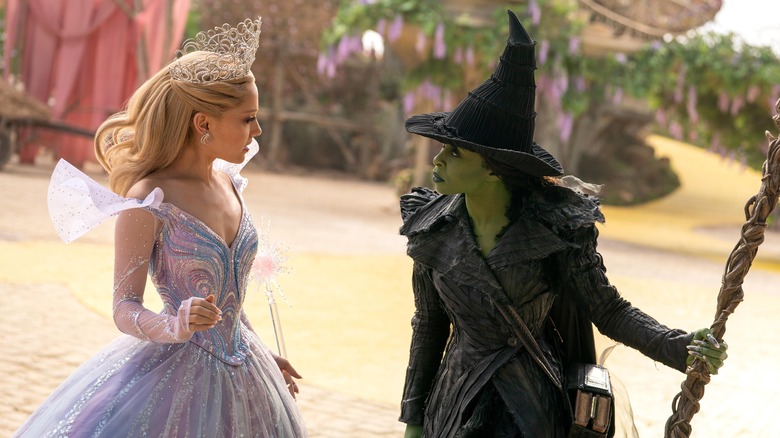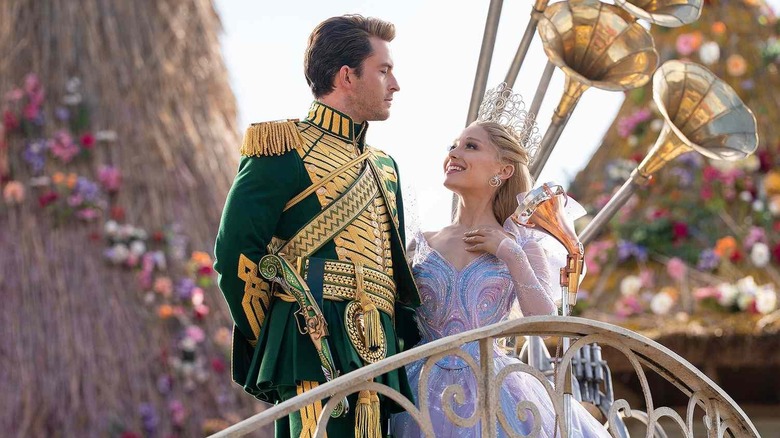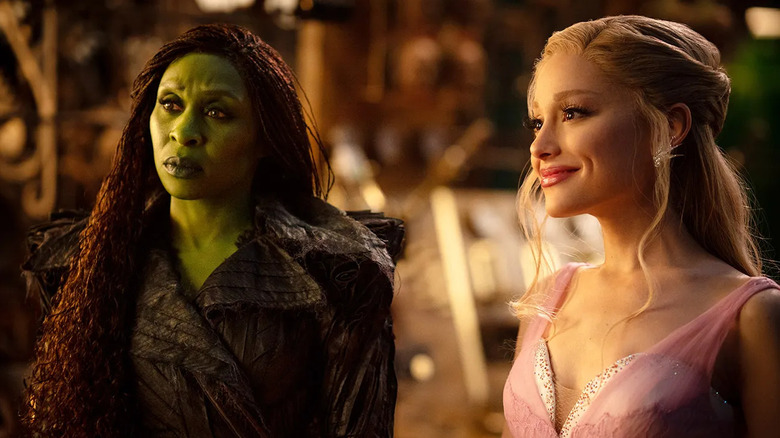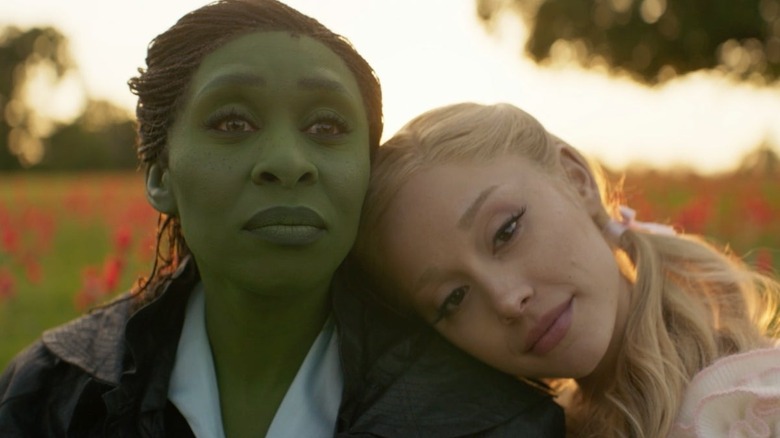Wicked: For Good Ending Explained - What Happens To Elphaba?
Do not traverse the yellow brick road if you haven't seen "Wicked: For Good" yet — hop on your broomstick, fly away, and come back once you've watched the movie, because there are massive spoilers ahead!
"Wicked: For Good" concluded the story of Elphaba Thropp, the verdant witch with wonderful powers played by Cynthia Erivo in Jon M. Chu's adaptation of the hit Broadway musical. So, what happens to her at the end?
I'll get there, but first, let's go over some of the basics regarding "Wicked: For Good." When Chu adapted the musical by Stephen Schwartz and Winnie Holzman — which itself is adapted from Gregory Maguire's "Wicked: The Life and Times of the Wicked Witch of the West," originally published in 1995 — he decided to split it into two parts, echoing the way the stage musical plays out. While this was a somewhat controversial choice, it did make sense; there's quite a lot going on in "Wicked," the story that serves as the backstory for the woman who eventually becomes the Wicked Witch of the West (a role that was, of course, originated by Margaret Hamilton in the 1939 classic "The Wizard of Oz"). Basically, throughout its various forms, "Wicked" asks one question: are people born wicked, or do they have wickedness thrust upon them?
When it comes to Elphaba, is she actually as wicked as the Wizard, played in Chu's films by Jeff Goldblum, claims, or is it the case that (if we're using Internet parlance) "Elphaba innocent?" Let's break it down.
What you need to remember about Wicked
In the first film, we meet Elphaba as she accompanies her sister Nessarose (Marissa Bode) to enroll in Shiz University; after Elphaba inadvertently causes a scene by casting a spell by accident, the school's dean of sorcery, Madame Morrible (a somewhat miscast Michelle Yeoh, who performs beautifully whenever she's not singing), insists she enroll as well. Because it's so last-minute, Elphaba is forced to room with the bubbly, blonde, and pink-clad Galinda Upland (Ariana Grande-Butera, who's absolutely transcendent in both films), and their mutual loathing is literally the subject of an entire musical number.
Over time, though, Galinda (who eventually shortens her name to "Glinda") and Elphaba (whom the rechristened Glinda often affectionately calls "Elphie") become best friends, and alongside the desirable Winkie prince Fiyero Tigelaar (Jonathan Bailey), Nessa, and her paramour of sorts Boq Woodsman (Ethan Slater), they find joy in their friendships and studies at Shiz. When Elphaba is invited to meet the Wizard of Oz himself, things take a turn. After she and Glinda discover he has absolutely zero magical powers and is a total fraud, Elphaba wants to turn against him and set the talking animals he's persecuted and hunted free, while Glinda is more than happy to act as a propagandist in exchange for power, influence, and comfort. The two best friends essentially agree to disagree before Elphaba flies off into the sunset and Glinda remains by Madame Morrible's side in Oz (yes, this is when "Defying Gravity" brings the house down at the end of "Wicked: Part One").
When Wicked: For Good begins, Oz is in a state of manufactured crisis
"Wicked: For Good" picks up roughly where the first film leaves off, which is to say that Elphaba, a wanted woman, is in hiding — and her best friend Glinda is ruling the roost back in central Oz. Glinda and Madame Morrible arranged for the former to marry a pretty unwilling Fiyero, who's now the head of the Wizard's army. Both Glinda and Fiyero are desperately worried for Elphaba, who spends her time flying high above Oz and writing messages in the sky about the Wizard's true nature (something that Madame Morrible, who can manipulate the weather using her magic, can tweak so that it looks like Elphaba is making threats to Oz at large).
In the lead-up to the wedding between Glinda and Fiyero, which is being used as a sort of state-sponsored presentation of forced unity by Madame Morrible and the Wizard, Elphaba visits her old friend, only for the two of them to go and see the Wizard in his chambers. For a while there, it looks like the Wizard might be able to persuade Elphaba to see his side of things. Unfortunately for the Wizard, just as he thinks he's convinced Elphaba to join his propaganda machine in Oz, she discovers something horrific. In a hidden chamber off of the Wizard's main quarters, he's keeping animals — ones he's stripped of speech and all but exiled from Oz proper — in cages. Righteously furious, Elphaba frees the animals, ruins Glinda and Fiyero's wedding, and then the movie really gets going.
Every major character experiences a full transformation, in one way or another, during Wicked: For Good
Some characters in "Wicked: For Good," like Elphaba and Glinda, undergo more internal and emotional journeys, with the former ultimately realizing that sometimes even her righteous efforts turn into disasters (Erivo's rendition of the Act II showstopper "No Good Deed" is particularly great) and the latter finally understanding that she needs to stand up for what's truly right and, well, good. Some characters undergo more literal transformations. As my wonderful colleague BJ Colangelo smartly highlighted in her review of "Wicked: For Good," the way the movie handles the spell Elphaba casts on Nessa is a huge improvement over the stage version; onstage, Nessa can walk again, but because Marissa Bode is an all too rare wheelchair user playing Nessarose, the movie chooses to let Elphaba levitate her sister as a temporary albeit joyful effect. Unfortunately, Nessa's joy is short-lived because when Boq stumbles across the scene, there's a confrontation, and to save him from a poorly cast spell by Nessa, Elphaba ends up transforming him into the Tin Man, taking away his heart.
We also see the Cowardly Lion all grown up (and yes, he's voiced by Colman Domingo for like, five seconds) and, later down the line, we realize that Fiyero's fate is fraught (I'll circle back to that in a moment). "Wicked: For Good" is all about inner and outer transformations, and that all comes to a head when, in an attempt to lure Elphaba out of hiding after she and Fiyero run away together, Madame Morrible puts Nessa in mortal danger. Unfortunately for everyone, this plan ends in tragedy, and Nessarose is killed by a falling house. (See where this is going?)
Towards the end of Wicked: For Good, Elphaba and Glinda mend fences ... but does Elphaba die?
After Nessa is killed by the falling house and Glinda gives her silver slippers — that once belonged to Nessa and Elphaba's late mother — to Dorothy, whose face is never featured in "Wicked: For Good," there's newfound enmity between Glinda and Elphaba. Both of them have reasons to be angry, however dubious. Elphaba is mourning the loss of her sister, with whom she was at odds after becoming the Wicked Witch of the West and Boq's transformation, and Glinda is devastated that Fiyero left their wedding to go and be with Elphaba (those two consummate their relationship after the gorgeous ballad "As Long As You're Mine"). The two duke it out alone on the Yellow Brick Road before the Wizard's guard arrives, arresting Fiyero as Elphaba escapes.
Fiyero is beaten to within an inch of his life but survives thanks to a hasty spell cast by Elphaba from afar that turns him into — you guessed it — the Scarecrow, a form that ensures he can't spill blood or break bones. As mobs, led by a furious Boq, head out to destroy Elphaba once and for all, Glinda heads to the Wicked Witch of the West's secret hideout (guarded by the flying monkeys, who have now allied themselves with Elphaba) to reason with her beloved Elphie. The two settle their differences, sing "For Good" — the friendship ballad that gives the sequel its subtitle — and then Elphaba dies when Dorothy throws water on her, just like in the 1939 movie. Or does she?!
There's a clever twist — and emotional gut punch — at the very end of Wicked
Before Elphaba "dies," she tells Glinda something vital: the "good witch" shouldn't rehabilitate Elphaba's image posthumously, because people need a common villain to rally against. After Dorothy tosses a pail of water on Elphaba, the Wicked Witch of the West "vanishes," and Glinda takes care of business. Not only does she confront the Wizard, confirm he's Elphaba's real father, and run him out of town, but she also has Madame Morrible imprisoned for her many crimes. After freeing the animals and welcoming all beings as Ozians — and promising to enact real change and "do good" — Glinda becomes the de facto leader of Oz, promising to usher in a brighter and more unified future.
Elphaba, though, she's very much not dead! Just like in the original musical, the entire water-induced death was a ruse meant to trick the Wizard and the population of Oz. Elphaba runs away with Fiyero to the land beyond Oz, which, to be honest, looks weirdly like the deserts of Denis Villeneuve's "Dune" (albeit a lot more computer-generated). In the very last moments of "Wicked: For Good," as Fiyero and Elphaba escape to a new life together, she experiences a telepathic connection with Glinda, who's now able to use the magical book known as the Grimmerie and learn real magic for the very first time. It's a stunning, fitting, and emotionally moving ending ... and when you see it, you'll be changed for good. (Sorry.)
"Wicked: For Good" is in theaters now.





